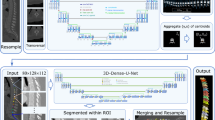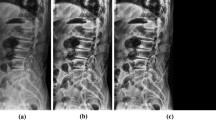Abstract
Accurate segmentation of the vertebrae from medical images plays an important role in computer-aided diagnoses (CADs). It provides an initial and early diagnosis of various vertebral abnormalities to doctors and radiologists. Vertebrae segmentation is very important but difficult task in medical imaging due to low-contrast imaging and noise. It becomes more challenging when dealing with fractured (osteoporotic) cases. This work is dedicated to address the challenging problem of vertebra segmentation. In the past, various segmentation techniques of vertebrae have been proposed. Recently, deep learning techniques have been introduced in biomedical image processing for segmentation and characterization of several abnormalities. These techniques are becoming popular for segmentation purposes due to their robustness and accuracy. In this paper, we present a novel combination of traditional region-based level set with deep learning framework in order to predict shape of vertebral bones accurately; thus, it would be able to handle the fractured cases efficiently. We termed this novel Framework as “FU-Net” which is a powerful and practical framework to handle fractured vertebrae segmentation efficiently. The proposed method was successfully evaluated on two different challenging datasets: (1) 20 CT scans, 15 healthy cases, and 5 fractured cases provided at spine segmentation challenge CSI 2014; (2) 25 CT image data (both healthy and fractured cases) provided at spine segmentation challenge CSI 2016 or xVertSeg.v1 challenge. We have achieved promising results on our proposed technique especially on fractured cases. Dice score was found to be 96.4 ± 0.8% without fractured cases and 92.8 ± 1.9% with fractured cases in CSI 2014 dataset (lumber and thoracic). Similarly, dice score was 95.2 ± 1.9% on 15 CT dataset (with given ground truths) and 95.4 ± 2.1% on total 25 CT dataset for CSI 2016 datasets (with 10 annotated CT datasets). The proposed technique outperformed other state-of-the-art techniques and handled the fractured cases for the first time efficiently.










Similar content being viewed by others
References
Levangie PK, Norkin CC: Joint structure and function: a comprehensive analysis, 5th edition. Philadelphia: F.A. Davis Co, p. 140 Print 2011
Middleditch A, Olive J: Functional anatomy of the spine. In: 2nd, Vol. 1-3. Oxford: MCSP. Butterworth-Heinemann, 2005
Tang F-h et al.: Computer-generated index for evaluation of idiopathic scoliosis in digital chest images, a comparison with digital measurement. J Digit Imaging 21:113–120, Springer, 2007. https://doi.org/10.1007/s10278-007-9050-7.
Zhou Y, Liu Y, Chen Q, Gu G, Sui X: Automatic lumbar MRI detection and identification based on deep learning. J Digit Imaging, Springer, 2018. https://doi.org/10.1007/s10278-018-0130-7
Wang KC, Jeanmenne A, Weber GM, Thawait S, Carrino JA: An online evidence-based decision support system for distinguishing benign from malignant vertebral compression fractures by magnetic resonance imaging feature analysis. J Digit Imaging 24(3):507–515, Springer, 2010. https://doi.org/10.1007/s10278-010-9316-3
Johnell O, Kanis JA: An estimate of the worldwide prevalence and disability associated with osteoporotic fractures. Osteoporos Int 17:1726–1733, 2007. https://doi.org/10.1007/s00198-006-0172-4
Melton LJ, Atkinson EJ, O'Connor MK, O'Fallon WM, Riggs BL: Bone density and fracture risk in men. J Bone Miner Res 13:1915–1923, 1998
Das C, Baruah U, Panda A: Imaging of vertebral fractures. Indian J Endocr Metab 18(3):295–303, 2014. https://doi.org/10.4103/2230-8210.131140
Hernlund E et al.: Osteoporosis in the European Union: medical management, epidemiology and economic burden. Springer. Arch Osteoporos, 2013
Nevitt MC, Ettinger B, Black DM, Stone K, Jamal SA, Ensrud K, Segal M, Genant HK, Cummings SR: The association of radiographically detected vertebral fractures with back pain and function: a prospective study. Ann Intern Med 128:793–800, 1998
Anwar SM et al.: Medical image analysis using convolutional neural networks: A Review. Springer. J Med Syst 42:1–13, 2018
Litjens G, Kooi T, Ehteshami Bejnordi B, Setio A, Ciompi F, Ghafoorian M, van der Laak J, van Ginneken B, I. Sánchez C: A survey on deep learning in medical image analysis. Med Image Anal 42:60–88, 2017. https://doi.org/10.1016/j.media.2017.07.005.
Ronneberger O, Fischer P, Brox T: U-net: convolutional networks for biomedical image segmentation. In: International conference on medical image computing and computer-assisted intervention. Berlin: Springer, 2015, pp. 234–241
Chan TF, Vese LA: Active contours without edges. TIP 10(2):266–277, 2001
Kass M, Witkin A, Terzopoulos D: Snakes: active contour models. Int J Comput Vis 1(4):321–331, 1988. https://doi.org/10.1007/BF00133570
Mahmoudi S, Benjelloun M: A new approach for cervical vertebrae segmentation. CIARP, 2007
Klinder T, et al: Spine segmentation using articulated shape models. Medical image computing and computer-assisted intervention: MICCAI, International Conference on Medical Image Computing and Computer-Assisted Intervention 11 Pt 1, 2008, pp 227–34
Roberts MG, et al: Segmentation of lumbar vertebrae using part-based graphs and active appearance models. Medical image computing and computer-assisted intervention: MICCAI, International Conference on Medical Image Computing and Computer-Assisted Intervention 12 Pt 2, 2009, pp 1017–24
Benjelloun M, Mahmoudi S, Lecron F: A framework of vertebra segmentation using the active shape model-based approach. Int J Biomed Imaging 2011:1–14, 2011
Mysling P, Petersen K, Nielsen M, Lillholm M: Automatic segmentation of vertebrae from radiographs: a sample-driven active shape model approach. In: Suzuki K, Wang F, Shen D, Yan P Eds. Machine learning in medical imaging. MLMI 2011. Lecture notes in computer science, Vol. 7009. Berlin: Springer, 2011
Liu X, Wu Y, Wang B: Spinal CT image segmentation based on level set method. 36th Chinese Control Conference (CCC), Dalian, 2017, pp 10956–10961. https://doi.org/10.23919/ChiCC.2017.8029105
Hille G, Saalfeld S, Tönnies K: Hybrid level-sets for vertebral body segmentation in clinical spine MRI. Procedia Computer Science. 90:22–27, 2016. https://doi.org/10.1016/j.procs.2016.07.005
Rastgarpour M, Shanbehzadeh J, Soltanian-Zadeh H: A hybrid method based on fuzzy clustering and local region-based level set for segmentation of inhomogeneous medical images. J Med Syst 38(8):68, 2014. https://doi.org/10.1007/s10916-014-0068-3
Sekuboyina A, Valentinitsch A, Kirschke JS, Menze BHA: Localisation-segmentation approach for multi-label annotation of lumbar vertebrae using deep nets. CoRR, abs/1703.04347, 2017
Sekuboyina A, Kukacka J, Kirschke JS, Menze BH, Valentinitsch A: Attention-driven deep learning for pathological spine segmentation. In: Computational methods and clinical applications in musculoskeletal imaging. Springer, volume 10734 of LNCS, 2018, pp 108–119. https://doi.org/10.1007/978-3-319-74113-0_10.
Janssens R, Zeng G, Zheng G: Fully automatic segmentation of lumbar vertebrae from CT images using cascaded 3D fully convolutional networks. In: IEEE 15th International Symposium on Biomedical Imaging (ISBI), 2018, pp 893–897. https://doi.org/10.1109/isbi.2018.8363715
Lessmann N, van Ginneken B, Išgum I: Iterative convolutional neural networks for automatic vertebra identification and segmentation in CT images. In: Medical imaging. Volume 10574 of Proceedings of SPIE, 2018, p 1057408
Lessmann N, van Ginneken B, de Jong PA, Išgum I: Iterative fully convolutional neural networks for automatic vertebra segmentation and identification. In: Medical image analysis. Volume 53, 2019, pp 142–155. https://doi.org/10.1016/j.media.2019.02.005
Al Arif SMMR, Knapp K, Slabaugh G: Fully automatic cervical vertebrae segmentation framework for X-ray images. Comput Methods Prog Biomed 157:95–111, 2018. https://doi.org/10.1016/j.cmpb.2018.01.006
Kristiadi A, Pranowo P: Deep convolutional level set method for image segmentation. J ICT Res Appl 11:284, 2017. https://doi.org/10.5614/itbj.ict.res.appl.2017.11.3.5
Ngo TA, Lu Z, Carneiro G: Combining deep learning and level set for the automated segmentation of the left ventricle of the heart from cardiac cine magnetic resonance. Med Image Anal 35:159–171, 2017
Yao J, Burns JE, Forsberg D, Seitel A, Rasoulian A, Abolmaesumi P, Hammernik K, Urschler M, Ibragimov B, Korez R, Vrtovec T, CastroMateos I, Pozo JM, Frangi AF, Summers RM, Li S: A multi-center milestone study of clinical vertebral CT segmentation. Comput Med Imaging Graph 49:16–28, 2016. https://doi.org/10.1016/j.compmedimag.2015.12.006
Ibragimov B, Korez R, Likar B, Pernus F, Xing L, Vrtovec T: Segmentation of pathological structures by landmark-assisted deformable models. IEEE Trans Med Imaging 36:1457–1469, 2017. https://doi.org/10.1109/stmi.2017.2667578
Barrett WA, Mortensen EN: Interactive live-wire boundary extraction. Med Image Anal 1(4):331–341, 1997. https://doi.org/10.1016/S1361-8415(97)85005-0
Krizhevsky A, Sutskever I, E Hinton G: ImageNet classification with deep convolutional neural networks. Neural Inf Process Syst 25, 2012, 1997. https://doi.org/10.1145/3065386
Acknowledgments
We thank the challenge organizers of MICCAI CSI 2014 and CSI 2016 (xVertSeg.v1) datasets for acquiring the datasets, preparing reference ground truth segmentations and making them publically available. We also acknowledge Dr. Faiza, focal person, POF’s Hospital Wah Cantt, Pakistan, for providing us expert opinions and corrections from two clinical experts on annotated datasets of xVertSeg.v1 challenge.
Author information
Authors and Affiliations
Corresponding author
Ethics declarations
Conflict of Interest
The authors declare that they have no conflict of interest.
Ethical Approval
This article does not contain any studies with human participants or animals performed by any of the authors.
Additional information
Publisher’s Note
Springer Nature remains neutral with regard to jurisdictional claims in published maps and institutional affiliations.
Rights and permissions
About this article
Cite this article
Rehman, F., Ali Shah, S.I., Riaz, M. et al. A Region-Based Deep Level Set Formulation for Vertebral Bone Segmentation of Osteoporotic Fractures. J Digit Imaging 33, 191–203 (2020). https://doi.org/10.1007/s10278-019-00216-0
Published:
Issue Date:
DOI: https://doi.org/10.1007/s10278-019-00216-0




